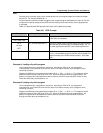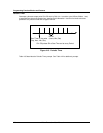
Programming Function Blocks and Features
Video Recorder – User Manual 129
Carbon Potential
The Carbon Potential Control Function Block provides for weight percent (wt%) control of carbon in
carburizing, hardening, and atmosphere generating applications.
Table 4-38 Carbon Prompts
Prompt Range/Selections Definition
PROBE TYPE NONE, AACP, SUPER
SYS, MARATHON, FCC
Selection which represents the manufacturer of the
oxygen probe being used. This determines which
linearization equations are used for %C and dewpoint
calculations.
CARBON PROBE IN NUMBER, PARM, OFF Analog input that is connected to the oxygen probe mV
output.
PROBE TEMP INPUT NUMBER, PARM, OFF Analog input that is connected to the oxygen probe
temperature output.
TEMPERATURE UNIT NONE, F, C, K, R Temperature scale for this block. This selection must
match the temperature scale of the analog input that is
connected to the oxygen probe temperature output.
TEMP LOW LIMIT NUMBER, OFF Probe temperature value below which this block’s low
temperature discrete output (OS) is turned ON. This limit
and subsequent discrete output may be used to force the
control loop’s output to a known value when the probe
temperature is too low for carbon potential control.
CO COMPENSATION NUMBER, PARM, OFF Number used in the %C calculation which represents the
%CO present in the endothermic gas.
FURNACE FACTOR NUMBER, PARM, OFF Correction factor used to account for environmental
variation within the furnace chamber. In units of %C, this
factor is added directly to the %C value calculated from
probe output linearization.
SOOTING FACTOR ON, OFF Boolean value that determines whether the anti-sooting
factor output (A1) will be based linearly on probe
temperature (SOOTING FACTOR=ON) or a constant
value of 2.0 (SOOTING FACTOR=OFF). If SOOTING
FACTOR is ON, a probe temperature of 1408 °F or
below limits %C output to 0.75% and 2086 °F or above
limits %C output to 2.0%.
PERCENTAGE
HYDROGEN
NUMBER, OFF Number representing %H
2
that is used in the dewpoint
calculation.


















